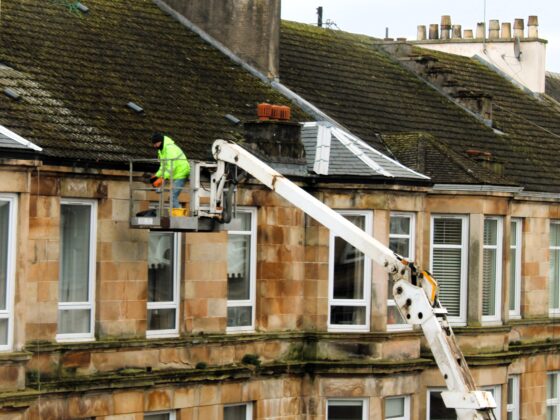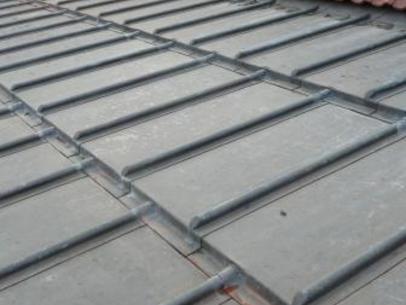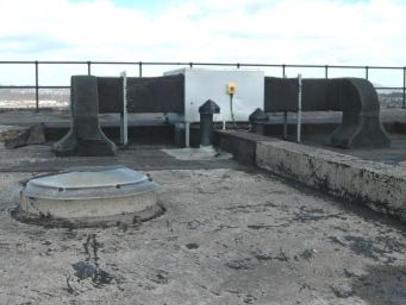Cracks can occur in your building for a variety of reasons. Establish the likely cause for your crack and, if it might be serious, take professional advice.
Cracks can occur in multiple places in your building, such as around windows and bays, in walls and brick walls, in the close, in the stair tread, and in plasterwork.
 Crack in stone lintels. This may suggest the presence of rotten timber ‘safe lintels’ behind.
Crack in stone lintels. This may suggest the presence of rotten timber ‘safe lintels’ behind.
Cracks around windows and bays
- cracks in stone lintels may be due to weakness in the stone or rot in the inner timber lintel
- cracks which extend above and below the lintel may be due to settlement of part of the building
- cracks in the joints of lintels at bay and oriel windows may be due to rust in the iron fixings embedded in the lintel
- cracking in the padstone supporting the lintel at bay and oriel windows may be due to the lintel being poorly seated, stressing one small area and causing it to crack
- cracks in corbels under oriel windows need to be inspected by a structural engineer
 Stapling a cracked stone. The steel staples will be covered with coloured mortar.
Stapling a cracked stone. The steel staples will be covered with coloured mortar.
Cracks in walls
There are a number of possible causes for cracks in stone walls, including weak ground conditions, movement in the ground due to subsidence or changes in the water table within the ground. Cracks will often follow the ‘line of least resistance’ through the window or door openings, where masonry is thinner.
Large cracks which carry up a wall structure and pass through stones may suggest differential settlement. This is where part of the building settles faster than other parts due to different ground conditions underneath. Where these cracks are long-standing, and there is no recent movement, there is often little cause for concern. However, a structural engineer should be consulted, and they may recommend monitoring the crack for movement using glass ‘tell tales’.
- cracks in cement stone repairs are common place, due to the shrinkage of the mortar – not to be confused with structural movement
- cracks in cement mortar are more likely than cracks in lime mortar
- fine hairline cracks in stone may not be a problem if they have been there for some time, but recent or enlarging cracks, or cracks which appear suddenly, should be seen by a structural engineer
 A crack that needs repointing. Lime mortar would be better than the cement used here.
A crack that needs repointing. Lime mortar would be better than the cement used here.
Cracks in brick walls
Cracks across bricks may be due to expansion/contraction of the brick which is more common where brickwork is pointed with cement rather than lime.
Cracks across bricks in timber kit buildings may result from the timber kit’s shrinkage, causing the brick skin to bear the entire roof load and crack under stress.
External cracks associated with sticking doors, cracked cornices or floors which slope suggest structural movement and should be inspected by an engineer urgently.
Separation cracks in the close
 Separation crack in common stair. Separation cracks may be due to a number of causes.
Separation crack in common stair. Separation cracks may be due to a number of causes.
Vertical cracks between the close walls and the outer walls are known as separation cracks. They may be caused by:
- the walls supporting the stairs are normally plastered ‘on the hard’, whilst external stone walls are lath and plaster and this can lead to cracks where they join (not a structural issue)
- brick stair walls may have been poorly tied to the outer stone walls
- one set of walls may have settled more than the other set of walls
- the outer wall may be bulging because of rot in the joists which tie the front and back of the building together
Stair tread cracks
Stair tread cracks is an issue to be taken seriously with open pencheck stairs, where each step rests on the other. This issue is likely to be less serious where the outer edge of the stair is supported by a steel beam.
- fix single cracked treads with stainless steel staples or replace the tread (a difficult job)
- if more treads are cracked then stairs may need strengthening or rebuilding – take structural engineer advice
- if the cracks are simply in the surface of a cement repair to the tread, then it is simply the cement that has failed, not the stone tread
Cracks in plasterwork
Cracks can appear in many places. Cracks can develop where there is a change in the backing material – from brick to plasterboard for instance. If they are just hairline cracks in the plaster and not extending deeper into the wall, then cutting out the crack and filling it will suffice.
Ceiling cracks can develop if the plaster works loose from the laths because of water damage or vibration. If the ceiling is also bowed, it may be on the point of collapse and need attention.
Cracks that go through the brick or stonework behind as well are more likely to be of a structural nature.
Solutions
Narrow cracks between stones can be dealt with by repointing with lime mortar.
Internal hairline cracks in plaster can be dealt with by decoration.
Cracks across stones should be checked by a builder or surveyor as they may indicate other problems and need treating. If there is no indication of more major problems, the cracks may be left untreated, filled with a coloured lime-based mortar or stitched with stainless steel staples.
Cracks up to about finger width can normally be dealt with by a competent builder.
Separation cracks may require stainless steel rods to be fixed through the tenement. These will be fixed to steel plates in the outer walls and the rods may be also be secured to floor joists.
 Cracking in precast lintel. Steel reinforcement in lintel has rusted causing the lintel to crack. Moisture seeping through the gap in pointing above is a likely cause.
Cracking in precast lintel. Steel reinforcement in lintel has rusted causing the lintel to crack. Moisture seeping through the gap in pointing above is a likely cause.
Professional help recommended?
You should always seek professional advice if your building needs this kind of work.
Depending on the location and extent of cracks, it is advisable to have them checked by a structural engineer who may decide to monitor the cracks with glass ‘tell tales’ to see if the movement is continuing. The structural engineer can specify and supervise necessary building work. Where work is extensive, it may be worth considering if other repairs are required.
Further information




